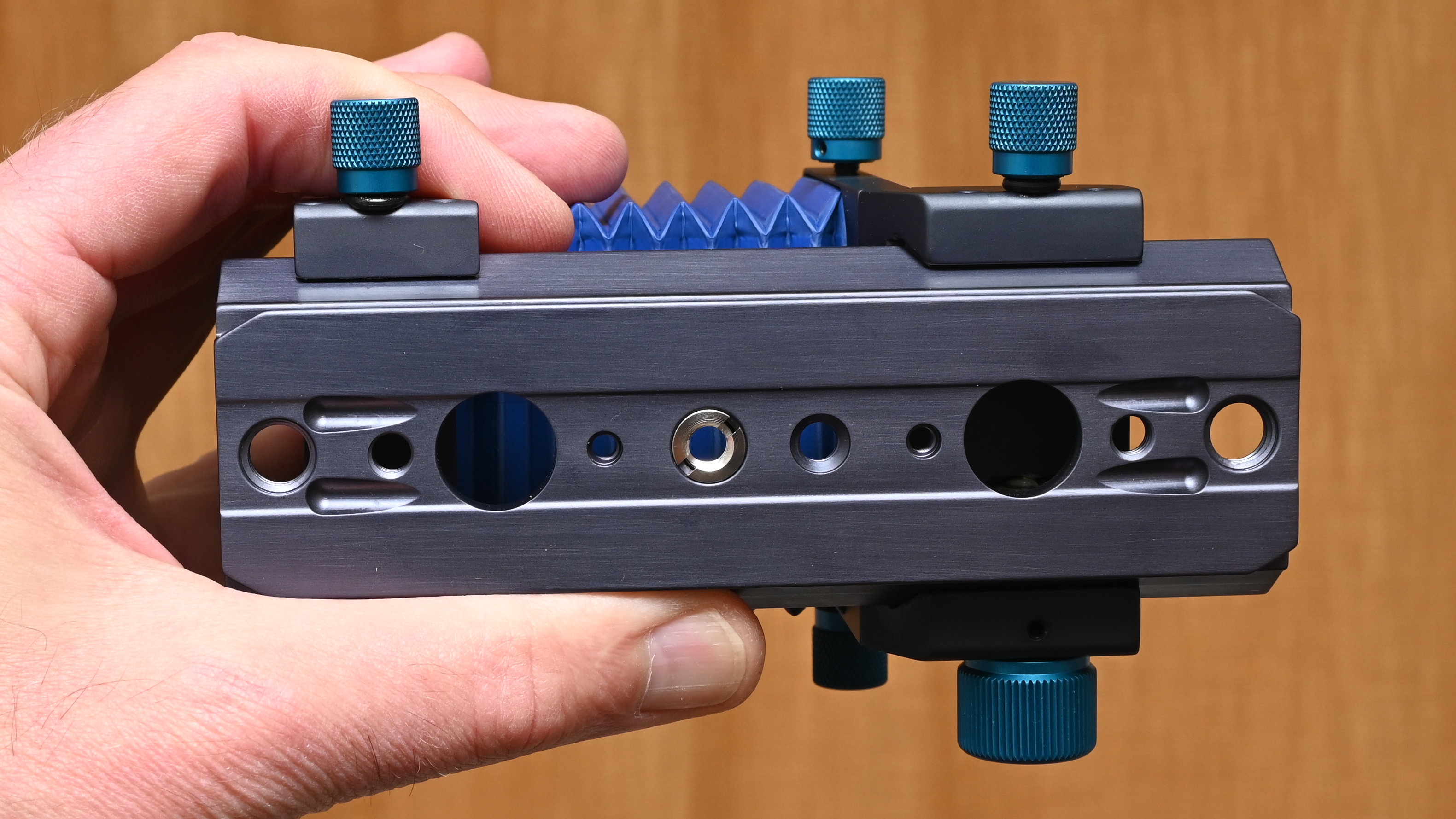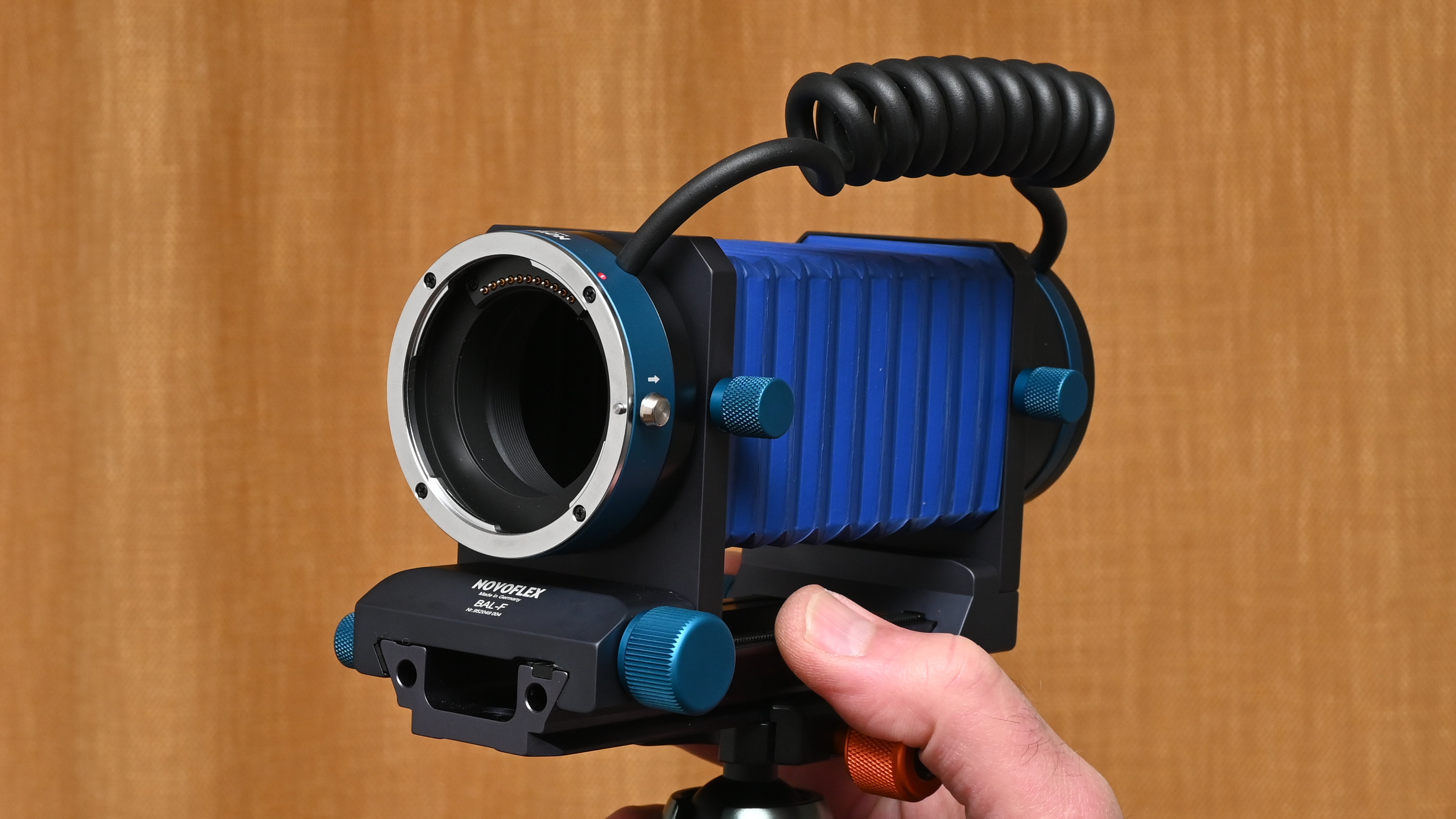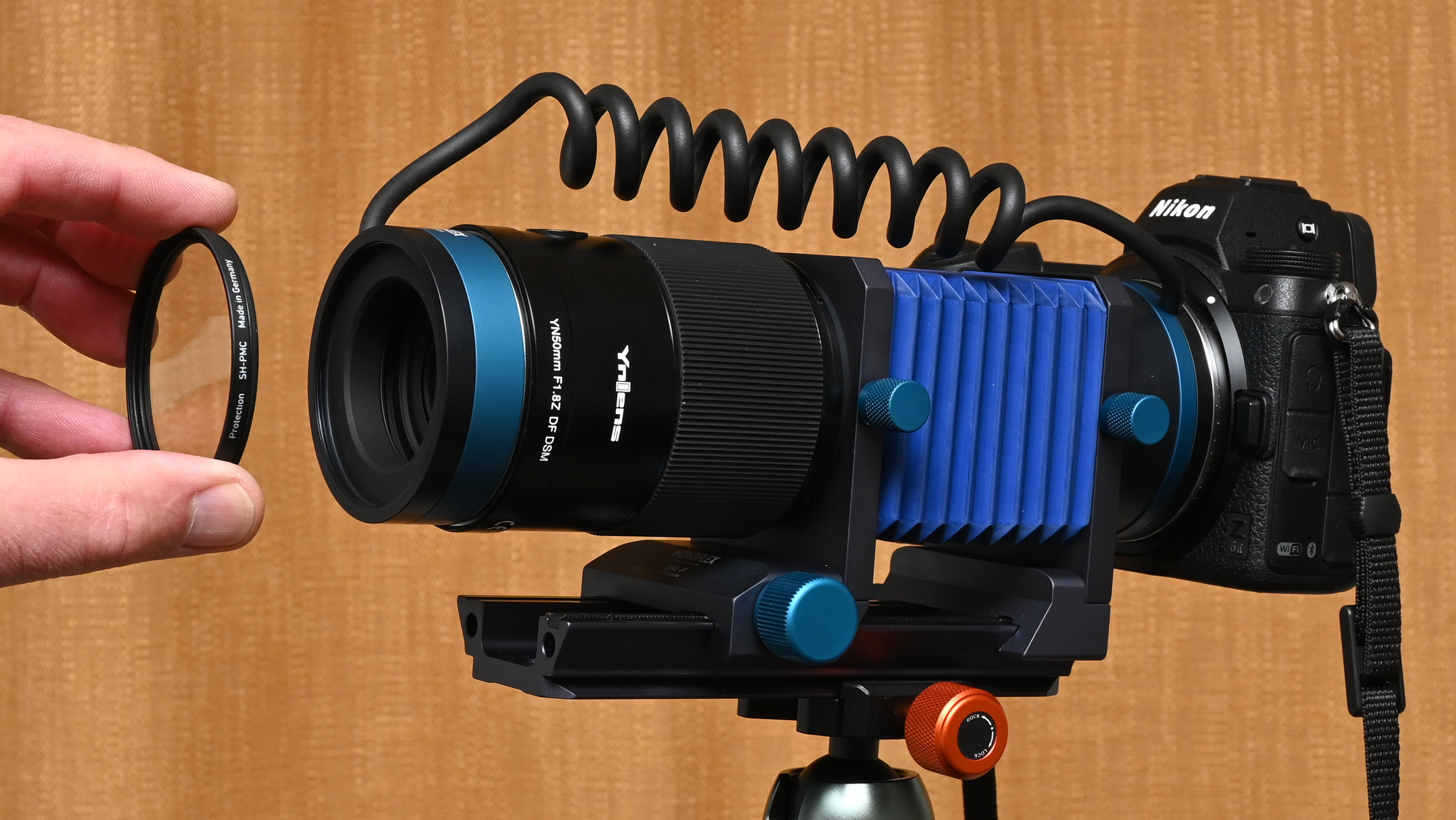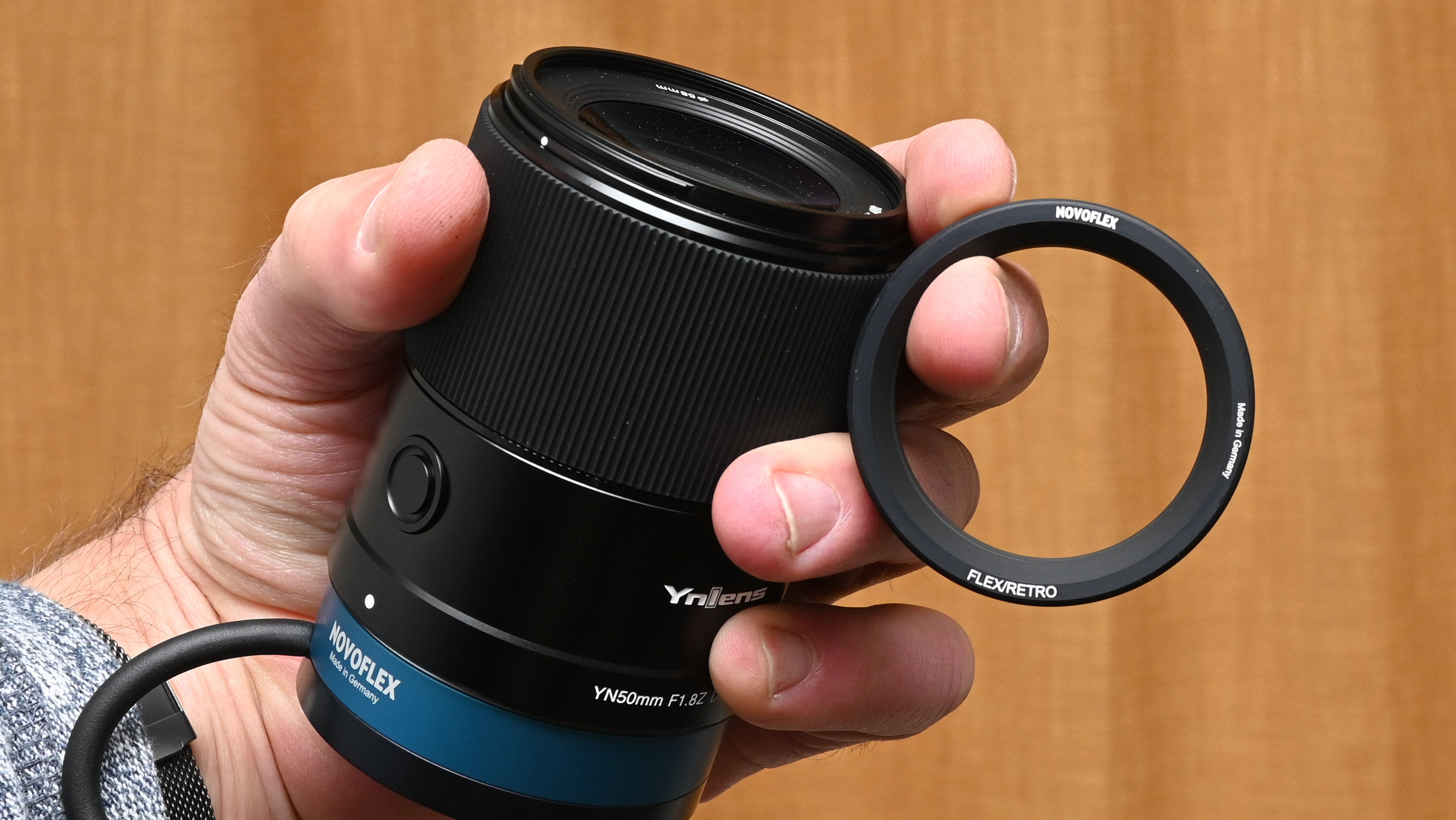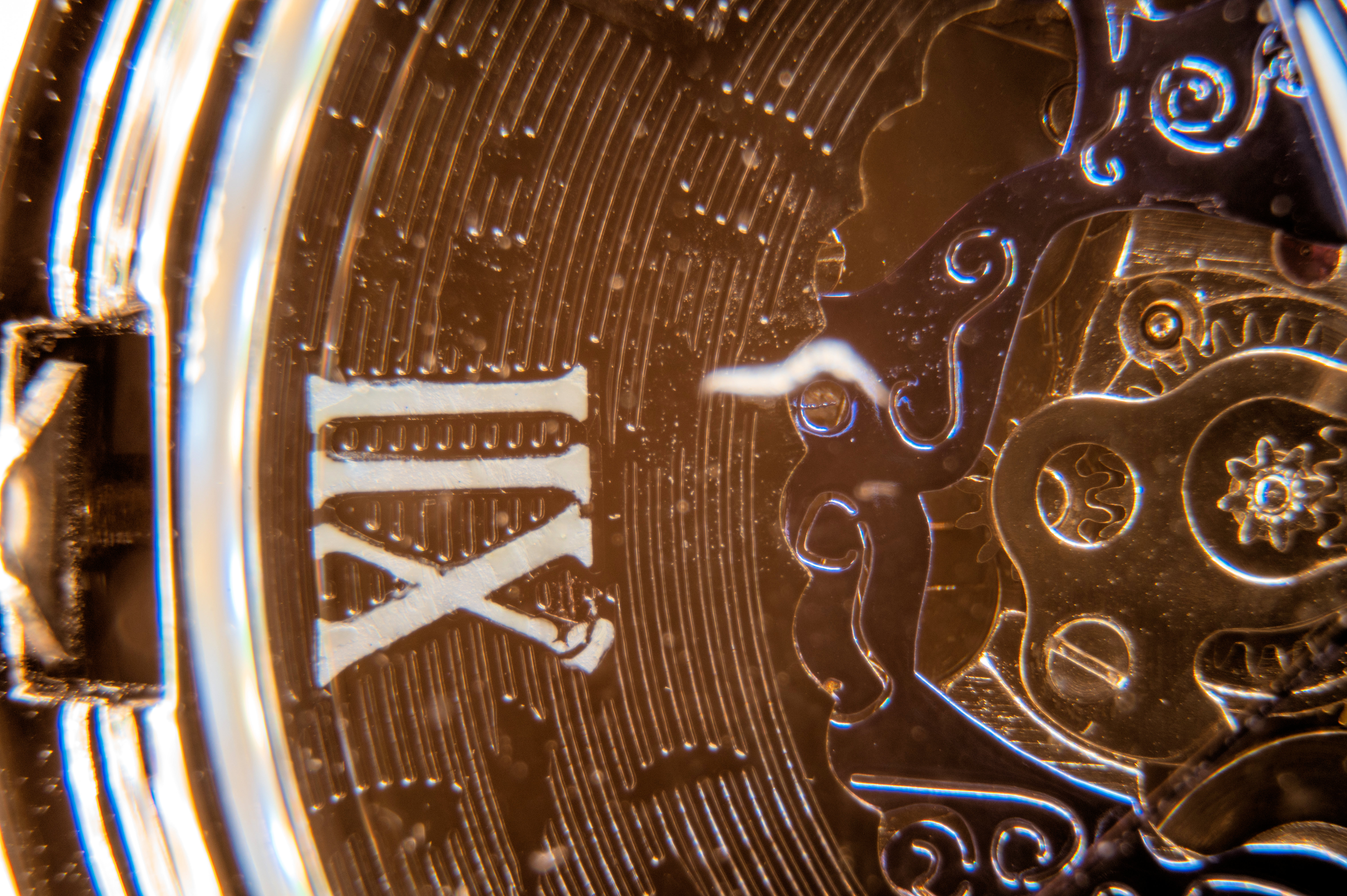Digital Camera World Verdict
The Novoflex Auto Bellows solves a problem for me. If I want more than 1.0x macro magnification, it delivers, and without even using a macro lens – pretty much any lens will do. I like that it enables full electronic communication between the camera and lens at either end of the bellows, and it’s beautifully well made. However, it’s a bit fiddly in use and working distances can be uncomfortably close.
Pros
- +
Up to 7x macro magnification
- +
Full camera/lens communication
- +
Well engineered, smartly finished
- +
Wide range of dedicated mount options
Cons
- -
Working distance can be tiny
- -
More fiddly than using a macro lens
- -
Expensive to buy
Why you can trust Digital Camera World
I’m sure I’ve got an old bellows camera in the attic somewhere buy I’ve not seen it for years and it’s from an era that very much predates my entry into the wonderful world of photography. Macro bellows are something rather different. Mount a camera body at one end and a lens at the other, and you can increase the magnification of any standard lens by extending the distance between the lens and camera. It’s like using extension tubes but fully and seamlessly adjustable.
The upside is that I can get large magnification factors using any lens, not just a macro lens. The downside is that macro bellows units typically have no electronic communication between the lens and camera. This rules out automatic exposure metering, autofocus, the recording of lens-based EXIF data and, unless I’m using a lens with a physical aperture control ring, I can only shoot at the lens’s widest aperture.
This Auto Bellows unit from the somewhat legendary German company, Novoflex, solves the problem by enabling full electronic communication between the camera and lens. As such, it aims to give a viable alternative to some of the best macro lenses on the market.
Novoflex Auto Macro Bellows: Specifications
| Mount options | Canon EF, RF, Nikon F, Z, Sony E, Fujifilm X, Leica L, Micro Four Thirds |
| Typical magnification | 1.0x to 7.0x |
| Min. extension | 29mm / 1.125” |
| Max. extension | 116mm / 4.56” |
| Height x width x depth | 10.3x13x10.3cm / 4.06x5.12x4.06” |
| Weight | 0.77kg / 1.7lbs |
Novoflex Auto Macro Bellows: Price
The key selling point of this ‘auto’ bellows unit is that it enables the camera body and lens to speak with each other. That relies not only on dedicated camera and lens mounting plates for specific camera systems, but also a stretchy cable to link them together. There’s a wide range of mount options on offer, including Canon EF & RF, Nikon F & Z, Sony E, Fujifilm X, Leica L (which suits Panasonic and Sigma full-frame cameras as well as Leica), plus Micro Four Thirds.
Each version of the kit costs around $1,285/£769. I’ve also seen a Fujifilm GFX medium format edition of the Auto Macro Bellows advertised in the USA for $1,799. They all cost a lot more than manual macro bellows options but that’s only to be expected. Indeed, they cost as much as some of the best macro lenses on the market, although these typically only give up to 1.0x magnification at their closest focus distances. The flip side is that, unlike a bellows unit, they can focus all the way to infinity so are useful for general photography instead of being limited to extreme close-ups.
Novoflex Auto Macro Bellows: Design & Handling
I got hold of the Nikon Z version of the Novoflex Auto Macro Bellows and, like others in the range, it comes as a kit of parts. The bellows unit itself has a sturdy base plate with a dovetail Arca-Swiss compatible profile, for easy mounting onto a compatible tripod head. And if you don’t have one of these, there are also 3/8” and ¼” threaded holes along with four cutouts for safety pins and two further threaded holes for video pins. Drive knobs are featured front and rear for precise movements and extension of the bellows, along the geared rack, which also features a numbered scale for easy reference. Supplemental locking knobs keep finalized adjustments securely fixed in place.
Attachment of the camera and lens is courtesy of a ‘Camera connector’ which fits into the camera body’s bayonet lens mount, and a ‘Lens connector with release button’ that attaches to the lens. Both are made from metal and feel very solid yet lightweight, excellently engineered and finished. The two items are joined together with a coiled cable catering to the extending and contracting length of the bellows. Again, the cable feels very durable of excellent quality, wired into the gold-plated electronic contacts in both the camera and lens mounts.
The best camera deals, reviews, product advice, and unmissable photography news, direct to your inbox!
The kit I was sent also included a reverse adapter. This enables the lens to be reversed and mounted to the front end of the bellows via its filter attachment thread. It has a 58mm thread but step-up and step-down rings are available for lenses with all popular thread diameters from 37mm up to 82mm. Reversing the lens on the front of the bellows in this way enables even greater macro magnification.
You can leave the bellows unit out of the equation altogether and simply attach the mounting plates to each end of the lens. In this configuration, as a guide, Novoflex says that if you’re using a Canon EOS 24-105mm lens, you’ll get a maximum macro magnification of 2.81x at the short end of the zoom range. With a typical 35mm lens, you should be able to get anything from 1.0x right up to 7.0x macro magnification.
I was a bit concerned that the auto bellows unit would be tricky to assemble and that it would feel a little fragile in use. I was pleasantly surprised that all of the components fit to the camera and lens, and to each other, quickly and easily. Handling feels very smooth and precise, and all of the parts have a really high-quality and durable feel. One word of warning is that Novoflex says you must not hold down the lens release button on the lens connector when attaching it to the lens, otherwise the electronic communication with some cameras and lenses can be lost. No big deal, just bear in mind that the lens release button is purely for detaching the lens.
Novoflex Auto Macro Bellows: Performance
While the Novoflex Auto Macro Bellows is quite quick and easy to set up, it’s relatively fiddly in use. As I’ve mentioned, the amount of magnification is increased by extending the length of the bellows on its geared track, which is simple and intuitive enough. You can also reverse the fitment of lenses, typically with a focal length of 50mm or shorter, using the reverse adapter. Novoflex recommends a focal length of 35mm as being ideal, which tends to be capable of macro magnification factors of anything from 1.0x right up to a huge 7.0x magnification.
The complication comes in terms of focusing and working distance. While the electronic communication enables the use of autofocus, this doesn’t work well in practice. I found there was a lot of autofocus hunting involved and that autofocus would often completely fail to lock onto the subject. Indeed, Novoflex recommends switching to manual focus mode and physically moving the camera or the object being photographed to achieve focus. Ideally, it’s best to use an additional macro focusing rail. As such, Novoflex offers various options including the Castel Mini II, Castel Q and Castel XQ II, being of increasingly larger sizes respectively, all of which are sold separately. These enable very precise movement of the whole assembly, as well as allowing for accurate focus stacking if you want to take a series of shots to merge into a composite image with greater depth of field.
The other issue is that the working distance tends to be extremely short. I found that the front of an attached lens would often be almost touching the object that I was shooting, so you not only need to be careful about collisions but lighting can also be a problem. At moderate extension, I found there were a couple of inches or so to spare, so it effective to bounce flash off a nearby wall or use a flashgun remotely, off-camera. For shorter distances, the latter is preferable, and I also used LED photographic lights, but needed to apply lighting from a very severe angle. For reverse mounting of lenses, Novoflex recommends fitting a protection filter to avoid the risk of any damage at ultra-short working distances, and one was supplied in the kit that I received.
The actual image quality is naturally very dependent on the camera and lens that you’re using with the Auto Macro Bellows or in reverse fitment, either with or without the bellows. Using my Nikon Z 6II and kit Nikon Z 24-70mm f/4 S lens, I was very happy with the image quality of the results. Sharpness and clarity were very good indeed and automatic exposure metering proved consistently accurate.
Novoflex Auto Macro Bellows: Verdict
I’m very much impressed with the build quality of the Novoflex Auto Macro Bellows. I’d actually expect nothing less considering the typical selling price of around $1,285/£769. Personally, I’m happy with the 1.0x magnification of a regular macro lens and, for my Nikon Z system cameras, I find that the excellent Nikon Z MC 105mm f/2.8 VR S Macro is a better proposition with a much more comfortable working distance, costing around $847/£869. Naturally, I can also use this as a regular lens for portraiture and in other scenarios where I want a short telephoto focal length, focusing right out to infinity instead of being limited to very short focus distances. If you want greater macro magnification of up to 7.0x, for example when using a 35mm lens, the Novoflex Auto Bellows is an intriguing kit that can really deliver for extreme close-ups, so long as you can live with really short working distances.
| Features | As a macro bellows kit, the Novoflex has all the features you could want and more. | ★★★★★ |
| Design | It’s expertly designed and beautifully engineered, typical of high-end Novoflex products. | ★★★★★ |
| Performance | Image quality is dependent on your camera and lens, but short working distances can be tricky. | ★★★★ |
| Value | It’s expensive to buy, even compared with some of the best dedicated macro lenses on the market. | ★★★★ |
Should you buy the Novoflex Auto Macro Bellows?
✅ Buy this...
- You want more than 1.0x macro magnification, right up to 7.0x with most 35mm prime lenses.
- You don’t mind the fiddly nature of using macro bellows, compared with a dedicated macro lens.
🚫 Don't buy this...
- You’d rather have the simplicity of fitting a macro lens directly to your camera body and don’t mind being limited (typically) to 1.0x magnification.
- You’re happy to set your exposure manually with a lens that has an aperture control ring, in which case manual bellows will save you a lot of money.
Alternatives
The AstrHori 25mm F2.8 Macro 2.0x-5.0x is a fully manual, dedicated macro lens for shooting at short distances only, no bellows required. It delivers up to 5.0x macro magnification and is available in Canon RF, Fuji X, Leica L, Nikon Z and Sony E mount options.
The Laowa 90mm F2.8 2x Ultra Macro APO is a fully manual lens, so you need adjust the aperture as well as the focus distance via control rings on the lens itself. Even so, it delivers excellent image quality at up to 2.0x macro magnification and is available in Canon RF, Leica L, Nikon Z, Sony FE mount options.
Matthew Richards is a photographer and journalist who has spent years using and reviewing all manner of photo gear. He is Digital Camera World's principal lens reviewer – and has tested more primes and zooms than most people have had hot dinners!
His expertise with equipment doesn’t end there, though. He is also an encyclopedia when it comes to all manner of cameras, camera holsters and bags, flashguns, tripods and heads, printers, papers and inks, and just about anything imaging-related.
In an earlier life he was a broadcast engineer at the BBC, as well as a former editor of PC Guide.


